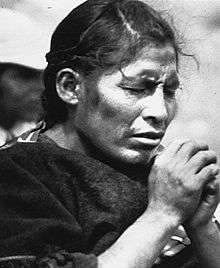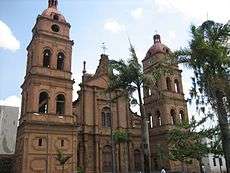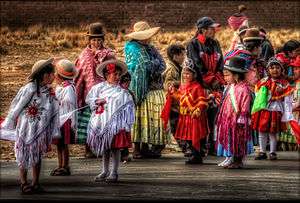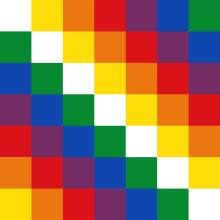Bolivians
|
| |
| Total population | |
|---|---|
| (c. 13 million) | |
| Regions with significant populations | |
|
| |
| ~1,000,000[1] | |
| 550,000[2] | |
| 163,553[3] | |
| 99,296[4] | |
| 31,313[5] | |
| Languages | |
| Spanish, Quechua, Aymara, Guarani and others (mainly Indigenous) | |
| Religion | |
| Predominantly Christian: Roman Catholic. Syncretism with native beliefs is widely practiced. Minorities (Baha'i, Mormon, Muslim, Buddhist, Hindu) | |
Bolivians (Spanish: Bolivianos) are the people that inhabit the Plurinational State of Bolivia. Amerindians lived in what is now called Bolivia for several millennia before the Spanish Conquest in the 16th century. Spaniards and Africans arrived in steady numbers under colonial rule, mixing widely with each other and with indigenous peoples.
The Bolivian population, estimated at 10.9 million is multiethnic, including Amerindians, Mestizos, Europeans, Asians and Africans. The main language spoken is Spanish, although the Guarani, Aymara and Quechua languages are also common and all three, as well as 34 other indigenous languages, are official. The many cultures in Bolivia have contributed greatly to a wide diversity in fields such as art, cuisine, literature, and music.
Ethnic groups
| Ethnic composition | |
| Indigenous-Native peoples self-identification ¹ | |
| Indigenous self-identification | 60 % |
| None self-identification | 40 % |
| Ethnic self-identification ² | |
| Mestizo | 68 % |
| Indigenous | 18 % |
| White | 7 % |
| Cholo | 2 % |
| Afro Bolivian | 1 % |
| Other | 1 % |
| n/a | 3 % |
| Notes: 1 = National Census of Population and Living 2001, National Statistics Institute of Bolivia (INE).[6] | |
| 2 = [7] | |
The ethnic composition of Bolivia includes a great diversity of cultures. Most of the indigenous peoples have assimilated a mestizo culture, diversifying and expanding their indigenous heritage. Consequently, there is in Bolivia a mix of cultures, which joins together Hispanic and Amerindian cultures.
The ethnic distribution of Bolivia is estimated to be 30% Quechua-speaking and 25% Aymara-speaking. The largest of the approximately three dozen native groups are the Quechuas (2.5 million), Aymaras (2 million), then Chiquitano (180,000), and Guaraní (125,000). So the full Amerindian population is at 55%; the remaining 30% are mestizo (mixed Amerindian and white), and around 15% are white.[8]
Indigenous
Indigenous, also called "originarios" ("native" or "original") and, less frequently, Amerindians. This ethnic group is composed by the descendents of the Pre-Hispanic cultures. They can be Andean, as the Aymaras and Quechuas (which formed the ancient Inca Empire), which concentrate in the western departments of La Paz, Potosí, Oruro, Cochabamba and Chuquisaca. There also is an important oriental ethnic population, composed by the Guaraní and Moxos, among others, and that inhabit the departments of Santa Cruz, Beni, Tarija and Pando. The indigenous people compose the 60% of the Bolivian population.
Mestizo
Mestizo are an ethnic mix of indigenous people and Europeans or Europeans descendants. They are distributed throughout the entire country and compose the 26% of the Bolivian population. Most people assume their mestizo identity while at the same time identifying themselves with one or more Indigenous cultures.
European
White Bolivians composed 12.72% or 231,088 of the total population in the 1900 census, the last official census that collected data of racial origin.[9] Most people of European origin are second-generation descendants of criollos and Europeans or Arabs, coming mostly from Spain, Croatia, Germany, Italy, Lebanon and Turkey.[8] They are usually concentrated in the largest cities — La Paz, Santa Cruz de la Sierra and Cochabamba — and in some minor cities like Tarija. In the Santa Cruz Department there is an important colony (70.000 inhabitants) of German-speaking Mennonites.[10]
Black African
Afro Bolivians are descendants of African slaves, who arrived in the times of the Spanish Empire. They inhabit the department of La Paz and in the provinces of Nor Yungas and Sud Yungas.
Other
- Asians. Mainly Japanese (14.000), Chinese (4.600), Koreans and Lebanese.
- Other: There are small amounts of European citizens of Germany, France, Italy and Portugal, as well as coming from other American countries, as Argentina, Brazil, Chile, Colombia, Cuba, Ecuador, United States, Paraguay, Peru, Mexico and Venezuela, among others. There are important Peruvian colonies in La Paz, El Alto and Santa Cruz de la Sierra. Bolivia is home to about 500 Jews, located mainly in the cities of La Paz, Cochabamba and Santa Cruz de la Sierra.
Indigenous peoples
The Indigenous peoples of Bolivia are divided into two ethnic groups: the Andeans, who are in the Andean Altiplano and the valley region, and the ethnic culture of the oriental Llanos region, who inhabit the warm regions of eastern Bolivia (Gran Chaco).
- Andean ethnicities
- Aymaras. They live on the high plateau of the departments of La Paz, Oruro and Potosí, as well as some small regions near the tropical flatlands.
- Quechuas. They inhabit mostly the valleys on Cochabamba and Chuquisaca. They also inhabit some mountain regions in Potosí and Oruro. They divide themselves into quechua nations, as the Tarabucos, Ucumaris, Chalchas, Chaquies, Yralipes, Tirinas, among others.
- Ethnicities of the Oriental Llanos
- Guaraníes. Formed by Guarayos, Pausernas, Sirionos, Chiriguanos, Wichí, Chulipis, Taipetes, Tobas and Yuquis.
- Tacanas: Formed by Tacanas, Lecos, Ese Ejas, Araonas, Reyesanos and Maropas.
- Panos: Formed by Chacobos, Caripunas, Sinabos, Capuibos and Guacanaguas.
- Aruacos: Formed by Apolistas, Baures, Moxos, Chané, Movimas, Cayabayas, Carabecas, Paiconecas or Paucanacas.
- Chapacuras: Formed by Itenez or More, Chapacuras, Sansinonianos, Canichanas, Itonamas, Yuracares, Guatoses and Chiquitos.
- Botocudos: Formed by Bororos y Otuquis.
- Zamucos: Formed by Ayoreos.
| N° | Group | Population | % | N° | Group | Population | % |
|---|---|---|---|---|---|---|---|
| 1 | Quechua | 1.558.277 | 15,54% | 6 | Afro Bolivian | 22.000 | 0,22% |
| 2 | Aymara | 1.098.317 | 10,95% | 7 | Movima | 10.152 | 0,11% |
| 3 | Chiquitano | 184.288 | 1,84% | 8 | Guarayo | 9.863 | 0,10% |
| 4 | Guaraní | 133.393 | 1,33% | 9 | Chiman | 4.528 | 0,05% |
| 5 | Moxo | 76.073 | 0,76% | 10 | Tacana | 3.056 | 0,03% |
| Source: Wigberto Rivero Pinto (2006)[11] | |||||||
Religion


The Roman Catholic church has a dominant religious presence in Bolivia. While a vast majority of Bolivians are Catholic Christians, a much smaller portion of the population participates actively. In the decades following the Second Vatican Council (1962–65), the Church tried to make religion a more active force in social life.
A 2008 survey for Americas Barometer, with 3,003 respondents and an error (+/- 1,8%)[12] returned these results:
| Religion | Percentage | Notes |
|---|---|---|
| Catholic | 81.6% | |
| Evangelical | 10.3% | Pentecostal, Non-Catholic Charismatic |
| No religion | 3.3% | Secular, Atheist |
| Other Protestant | 2.6% | Historic Protestant: Adventist, Baptist, Calvinist, Salvation Army, Lutheran, Methodist, Nazarene, Presbiterian |
| Mormon and Jehova's Witness | 1.7% | |
| Non-Christian | 0.4% | Bahá'í Faith, Jewish, Muslim, Buddhist, Hindu |
| Traditional religions | 0.1% | Native religions |
Other reviews of the population vary from these specific results.[13]
Culture

Some cultural development of what is now Bolivia is divided into three distinct periods: pre-Columbian, colonial, and republican. Important archaeological ruins, gold and silver ornaments, stone monuments, ceramics, and weavings remain from several important pre-Columbian cultures. Major ruins include Tiwanaku, Samaipata, Inkallaqta and Iskanwaya. The country abounds in other sites that are difficult to reach and hardly explored by archaeologists.
The Spanish brought their own tradition of religious art which, in the hands of local indigenous and mestizo builders and artisans, developed into a rich and distinctive style of architecture, literature, and sculpture known as "Mestizo Baroque." The colonial period produced the paintings of Perez de Holguin, Flores, Bitti, and others, and also the works of skilled but unknown stonecutters, woodcarvers, goldsmiths, and silversmiths. An important body of native baroque religious music of the colonial period was recovered in recent years and has been performed internationally to wide acclaim since 1994. Bolivian artists of stature in the 20th century include, among others, Guzman de Rojas, Arturo Borda, María Luisa Pacheco, Master William Vega, Alfredo Da Silva, and Marina Núñez del Prado.
Dances
Many dances and songs contain elements from both the native and European cultures. Caporales seems to be the most popular Bolivian dance of present times — in a few decades it has developed into an enormously popular dance, not only in the Highlands where it originated, but also in the Lowlands and in Bolivian communities outside the country. In the Highlands, other traditional and still very popular dances are:
- Morenada
- Kullawada
- Diablada
- Ch'utas
- Waka waka
- Siklla (Wayra, Doctorcitos)
- Suri Sikuri
- Tinku
- Pukllay
- Tobas
- Awki awki
- Llamerada
- Cambitas
- Chacarera
- Afro-Bolivian Saya
In the Lowlands, there are:
- Macheteros
- Taquirari
- Chovena chiquitana
- Brincao
- Carnavalito"
- El Sarao"
- Los moperas
- La Paica
- Danzas del Sol y de la Luna
- Danza de la Saraza
- Danzas de los pescadores
- Danzas del cazador amazónico
- Danza Rosita Pochi
- Arete guazú
- Toritos
- Danzas Vallegrandinas de Santa Cruz
- Cueca Cruceña
Clothing
It is fashionable among Bolivian Andean women of indigenous descent to wear a skirt called a pollera. It was originally a Spanish peasant skirt that the colonial authorities forced indigenous women to wear. Now it is a symbol of pride in being indigenous and is considered a status symbol.
Another fashion is the bowler hat, which was adopted from the British. The position of the hat can indicate a woman's marital status and aspirations.
Cuisine
Bolivian cuisine stems mainly from the combination of Spanish cuisine with traditional native Bolivian ingredients, with later influences from Germans, Italians, Basques, Croats, Russians, and Poles, due to the arrival of immigrants from those countries.
The traditional staples of Bolivian cuisine are corn, potatoes, and beans. These ingredients have been combined with a number of staples brought by the Spanish, such as rice, wheat, and meat, such as beef, pork, and chicken
See also
References
- ↑ Cónsul Boliviano con los días contados por Raúl Kollman, Página 12, 9 de abril de 2006.
- ↑ Deutsche Welle. "Brasil atrae gran número de inmigrantes bolivianos" (in Spanish). Retrieved 4 February 2014.
- ↑ Europapress. "Nueve de cada diez bolivianos en España ya están en situación regular" (in Spanish). Retrieved 4 February 2014.
- ↑ US Census Bureau 2012 American Community Survey B03001 1-Year Estimates HISPANIC OR LATINO ORIGIN BY SPECIFIC ORIGIN Archived August 15, 2014, at the Wayback Machine. retrieved September 20, 2013
- ↑ La Razón. "Bolivianos en Chile" (in Spanish). Retrieved 4 February 2014.
- ↑ INE (2001). "Autoidentificación con Pueblos Originarios o Indígenas de la Población de 15 años o más de edad- UBICACIÓN, ÁREA GEOGRÁFICA, SEXO Y EDAD". Retrieved 7 October 2009.
- ↑ Fundación Boliviana para la Democracia Multipartidaria (FBDM) y Fondo para la Democracia de Naciones Unidas (Undef) (13 March 2009). "Encuesta Nacional Sobre Valores y Actitudes Frente a la Conflictividad en Bolivia" (PDF). Retrieved 7 October 2009.
- 1 2 Bolivian people
- ↑ Censo National De La Poblacion de la Republica 1900 Census of Bolivia. "Segunda parte" - (Page: 25 - 32)
- ↑ Bolivian Reforms Raise Anxiety on Mennonite Frontier. The New York Times. 21 December 2006.
- ↑ "Archived copy". Archived from the original on 2013-01-17. Retrieved 2012-11-16.
- ↑ Americas Barometer Survey 2008 - page 11 Archived June 24, 2010, at the Wayback Machine.
- ↑ "Bolivia". National Profiles > > Regions > Central America >. Association of Religion Data Archives. 2010. Retrieved 2012-09-21.


